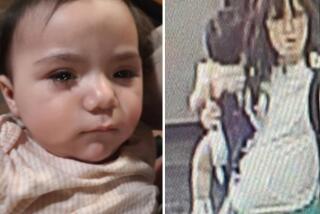Heart Transplant for Unborn Baby Planned at Loma Linda
- Share via
A pregnant Canadian woman Thursday arrived at Loma Linda University Medical Center, where doctors were prepared to deliver her baby by Caesarean section and then perform a heart transplant on the infant.
In a rapidly moving series of events, the 35-year-old woman was flown from Vancouver, Canada, by air ambulance after being notified that a donor heart might have become available for her unborn child.
“A potential donor, also from Canada, was found yesterday and is being evaluated at this time,” said a statement issued by Loma Linda officials.
“We plan to deliver the infant by C-section when a suitable donor is found,” added Dr. Leonard Bailey, chief of pediatric cardiac surgery at Loma Linda. “If the present donor does not prove to be satisfactory, we will wait. Meanwhile, the baby is in the best possible environment and is not due for another two or three weeks.”
The pregnant woman, identified by the Vancouver Sun as Alice Holt, is said to be in her 37th week of a normal 38-to-42-week pregnancy.
According to Loma Linda, the unborn baby was diagnosed nine weeks ago as having a heart defect known as hypoplastic left heart syndrome, a condition in which the side of the heart that pumps blood in the body’s principal artery fails to develop. Babies born with this condition often die within weeks, even days, of birth.
Holt was referred to Loma Linda, where the diagnosis was confirmed.
Alice Holt’s infant would be the second Canadian child this year to receive a heart transplant at Loma Linda. A 2 1/2-month-old girl from Calgary underwent such an operation in February.
Officials at Loma Linda, about 60 miles east of Los Angeles, were not commenting on the unfolding drama late Thursday, pending completion of the operations.
The world’s first successful infant heart transplant was done at Loma Linda on Nov. 16, 1985. The recipient, identified only as Baby Moses, was four days old at the time and also had the hypoplastic left heart syndrome. He was reported by Loma Linda officials to be “doing fine.”
Bailey since has performed seven more such operations on infants younger than six months, four of whom are still living.
Performing surgery on a newborn presents special problems in addition to those that confront an older person undergoing a heart transplant.
The size of a newborn’s heart is about the size of a walnut, and reconnecting the blood vessels demands special skills.
Perhaps more importantly, experts say, are the complications posed by the large number of physiological changes an infant normally undergoes in making the transition from the womb.
A procedure called echocardiography has now made it possible for doctors to diagnose heart defects such as the hypoplastic left heart syndrome in unborn infants as early as at 14 to 16 weeks after conception, according to Dr. Thomas Santulli Jr., a pediatric heart specialist at UCLA Medical Center.
Echocardiography uses an instrument that directs ultrasound waves at the fetus’s heart, producing a picture of the heart that reveals any structural abnormalities that may be present. The technique is different from fetal monitoring, which merely records heart rate.
Being able to diagnose the hypoplastic left heart syndrome before birth has made it possible, as in the case of the Holt family, for organ procurement agencies to begin looking for a donor heart much sooner than if the diagnosis were not made until birth.
More to Read
Sign up for Essential California
The most important California stories and recommendations in your inbox every morning.
You may occasionally receive promotional content from the Los Angeles Times.













